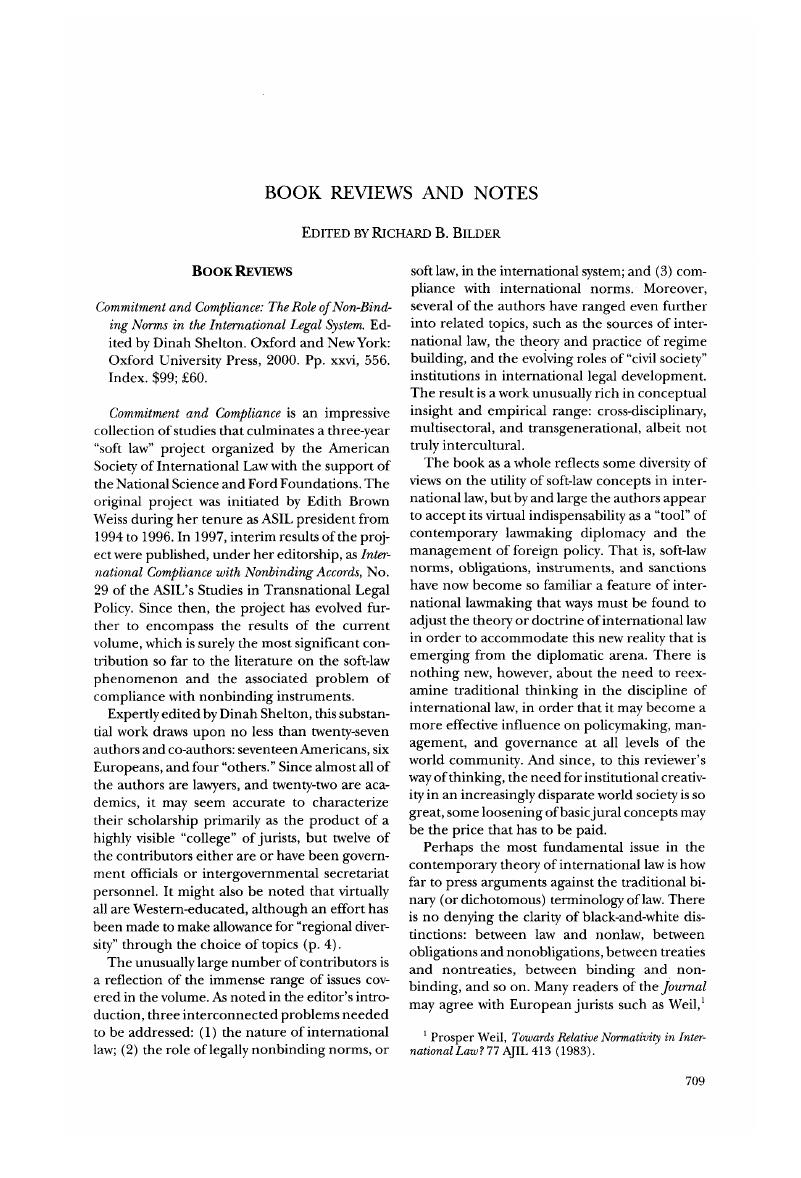Published online by Cambridge University Press: 06 June 2017

1 Weil, Prosper, Towards Relative Normativity in International Law? 77 AJIL 413 (1983)CrossRefGoogle Scholar.
2 Brownlie, Ian, The Rights of Peoples in Modem International Law, in The Rights of Peoples 1 (Crawford, James ed., 1988)Google Scholar.
3 Klabbers, Jan, The Redundancy of Soft Law, 65 Nordic J. Int’l L. 167 (1996)CrossRefGoogle Scholar; Klabbers, Jan, The Concept of Treaty in International Law (1996)Google Scholar.
4 Gennady, M. Danilenko, Law-Making in the International Community (1993)Google Scholar; Danilenko, G. M., Sources of International Law in a Changing International Community: Theory and Practice, in Perestroika and International Law 61 (Butler, W. E. ed., 1990)Google Scholar.
5 One of the firstborn of this family of “developmental” treaties was the 1976 Barcelona Convention for the Protection of the Mediterranean Sea Against Pollution, opened for signature Feb. 16, 1976, 15 ILM 290 (1976). A more recent and more famous example is the UN Framework Convention on Climate Change, May 9, 1992, S. Treaty Doc. No. 102-38 (1992), reprinted in 31 ILM 849 (1992).
6 Compare, for example, the recent Food and Agricultural Organization’s 1995 Code of Conduct on Responsible Fisheries, at <http://www.fao.org/fi/default.asp>, and the emerging code of conduct between the Association of South East Asian Nations and China on the preservation of peaceful relations in the South China Sea—which represents the latest stage of “confidence-building” diplomacy over the contested Spratly Islands.
7 Jonathan, I. Charney, Universal International Law, 87 AJIL 529 (1993)Google Scholar.
8 For an argument supporting three distinct models of international law—-juridical, operational, and societal— see Douglas, M. Johnston, Consent and Commitment in the World Community 81–95 (1997)Google Scholar.
9 See Chinkin, Christine, The Challenge of Soft Law: Development and Change in International Law, 38 Int’l & Comp.L.Q. 850 (1989)CrossRefGoogle Scholar.
10 Richard, B. Bilder, Breach of Treaty and Response Thereto, 67 ASIL Proc. 193 (1967)Google Scholar; Richard B. Bilder, Managing The Risks of International Agreement (1981).
11 This last observation reflects the present debate, chiefly in the international relations literature, on the feasibility of efforts to qualify the concept of state sovereignty in the interest of world community development. This debate touches upon the attainability of such goals as “universal international law” through evolution of “world arena commitments,” as distinct from formal acts of state consent. For new thinking about the concept of state sovereignty, see Special issue, Continuity and Change in the Westphalian Order, Int’l Stud. Rev., Summer 2000, at 1.
12 See James, N. Rosenau, Along The Domestic-Foreign Frontier: Exploring Governance in A Turbulent World (1997)Google Scholar.
13 See Allott, Philip, Eunomia: New Order for A New World (1990)Google Scholar.
14 23 FAO/CONF/RES 10/85 (Nov. 28, 1985).
15 UN Doc. UNEP/GC/DEC 15/30 (May 25, 1989).
16 Available online at <http://irptc.unep.ch/ethics/default.html>.
17 Convention on the Prior Informed Consent Procedure for Certain Hazardous Chemicals and Pesticides in International Trade, Sept. 11, 1998, UN Doc. UNEP/FAO/PIC/CONF/2, reprinted in 38 ILM 1 (1999).
18 Antarctic Treaty, Dec. 1, 1959, 12 UST 794, 402 UNTS 71.
19 Convention on the Conservation of Migratory Species of Wild Animals, June 23, 1979, 19 ILM 15 (1980).
20 Johnston, supra note 8. [Editor’s note: The book is reviewed by Robert, E. Dalton, 94 AJIL 204 (2000)Google Scholar.]
21 Richard, R. Baxter, International Law in ‘Her Infinite Variety; 29 Int’l & Comp. L.Q. 549 (1980)Google Scholar.
22 Aust, Anthony, The Theory and Practice of Informal International Instruments, 35 Int’l & Comp. L.Q. 787 (1986)CrossRefGoogle Scholar.
To send this article to your Kindle, first ensure no-reply@cambridge.org is added to your Approved Personal Document E-mail List under your Personal Document Settings on the Manage Your Content and Devices page of your Amazon account. Then enter the ‘name’ part of your Kindle email address below. Find out more about sending to your Kindle. Find out more about saving to your Kindle.
Note you can select to save to either the @free.kindle.com or @kindle.com variations. ‘@free.kindle.com’ emails are free but can only be saved to your device when it is connected to wi-fi. ‘@kindle.com’ emails can be delivered even when you are not connected to wi-fi, but note that service fees apply.
Find out more about the Kindle Personal Document Service.
To save this article to your Dropbox account, please select one or more formats and confirm that you agree to abide by our usage policies. If this is the first time you used this feature, you will be asked to authorise Cambridge Core to connect with your Dropbox account. Find out more about saving content to Dropbox.
To save this article to your Google Drive account, please select one or more formats and confirm that you agree to abide by our usage policies. If this is the first time you used this feature, you will be asked to authorise Cambridge Core to connect with your Google Drive account. Find out more about saving content to Google Drive.